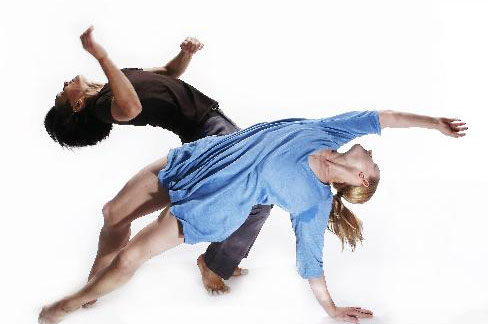This article originally appeared in the Culture section of Bloomberg News on February 26, 2009.

Dancers Eddie Taketa, left, and Natalie Desch perform in “Alchemy,” choreographed by Doug Varone, on Feb. 1, 2008. The dance piece, with music by Steve Reich, is being performed at New York’s Joyce Theater through March 1. Photographer: Phil Knott via Bloomberg News
Feb. 26 (Bloomberg) — A delicately built woman with boyish curly hair stands before a backdrop suggesting a prison of impermeable rock. Her head remains unbowed, her fingers tremble like antennae receiving messages and her eyes are lifted to some indefinable world beyond that still contains hope.
Set to Steve Reich’s “Daniel Variations,” Doug Varone’s “Alchemy,” given its New York premiere Tuesday night at New York’s Joyce Theater, takes off from a pair of stories — one ancient, one modern — referred to in the score. In 2002 the Jewish-American journalist Daniel Pearl was kidnapped by Islamist extremists in Pakistan and hideously murdered. The Daniel of the Old Testament maintains a steadfast faith in God despite life-threatening acts of violence against him; his tale is vivid with apocalyptic visions.
The frail-looking but unwavering woman (Erin Owen) appears to be an amalgam of both Daniels. Fellow captives join her: four men and three women who are repeatedly felled, physically and spiritually, by invisible oppressors who seem inhuman to a degree almost beyond imagination.
The victims never completely give up. They try to comfort one another, but there is no respite from their situation. They crawl along the floor, bodies contorted, struggle to rise only to fall again, flesh and bone thudding against the floor. On occasion they even turn upon one another, reduced to savage animals. Even the Daniel figure eventually succumbs, all hope extinguished.
Golden Glow
But then a golden glow shines down on the distorted, inert bodies. “Daniel” is the first to stand erect, raise her arms to the light, chest throbbing as if she’s received a definitive message about the essence of being fully human — to face the most terrible fates with one’s courage and identity intact. Slowly, her companions absorb it.
“Alchemy” is not, by a long shot, the most successful dance Varone has ever choreographed. The general theme suits his gifts but the parallel stories that inspired Reich don’t translate well into dance (or into music, for that matter). Varone’s attempt to make them work as a semi-abstract version of the haunting facts leaves too much vagueness in the air, which I suspect his fine dancers feel.
Nevertheless, Varone remains one of the most important choreographers on the scene. While not as well known as Paul Taylor, he operates in many genres: opera, spoken theater, the big and small screens — he may be the busiest choreographer in town.
At the same time, maintaining his own company, creating a repertory for this small group of quietly expressive dancers with unique stage personalities, remains the heart of his work. His pieces for them are typically poignant, often executed in subtly varied emotional shades of gray. They make the viewer feel: Yes, for good and ill, this is what life is like.
“Alchemy” is on a triple bill with the 2006 “Lux” to a Philip Glass score and a reworking of the 2000 “Tomorrow” to luscious Belle Epoque songs by Reynaldo Hahn.
Through March 1 at the Joyce Theater, 175 Eighth Ave. Information: +1-212-242-0800; http://www.joyce.org.
© 2009 Bloomberg L.P. All rights reserved. Reprinted with permission.



